|
July 1944 - July 1946
Formation and work-up
The personnel for 1846 Squadron assembled at
RNAS Donibristle and
Townhill Camp in June 1944, and sailed for the USA to form and train. The squadron officially formed on July 1st 1944 at
USNAS Brunswick as a single seat fighter squadron under the command of Lt. Cdr (A) D.G. Brooker RNVR.
The squadron was issued with 18 Corsair IIs, most of which had previously been used by 1843 squadron. After familiarisation with the aircraft and equipment the squadron began training in earnest to prepare for active service. Training included navigation exercises, low flying, formation flying and combat tactics.
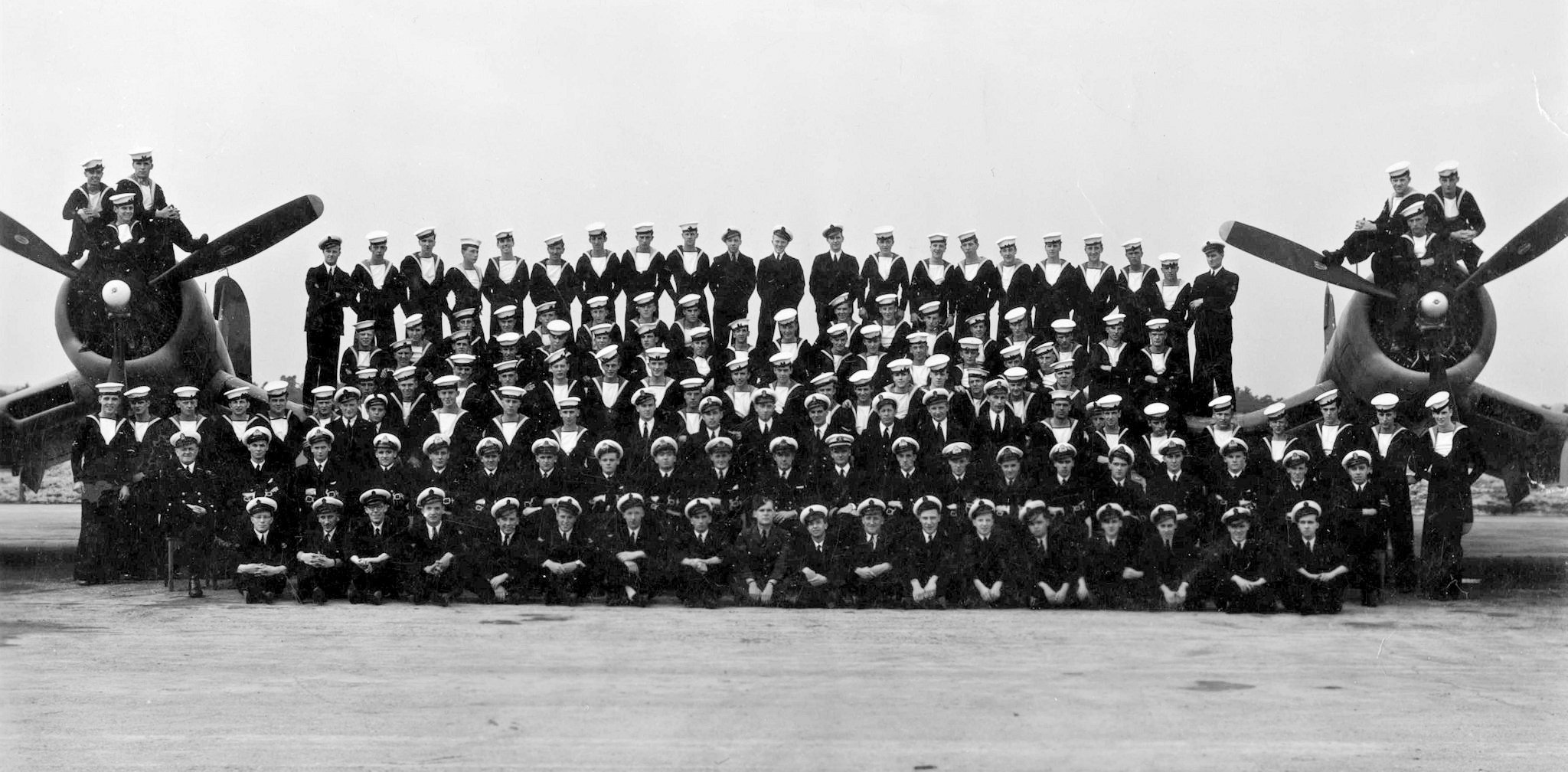 |
|
The personnel of 1846 Squadron at USNAS
Brunswick. C. August 1944. Photo courtesy Mr,
Ian Jones. Click on image to see larger
version |
The first month of flying was a difficult time for the new pilots, many of whom were on their first operational squadron; there were 10 aircraft accidents recorded during the period 10th to 23rd. Sub-Lt H. Briton RNVR had just parked Corsair JS878 after landing on the 10th when the tail wheel retracted. On the same date Sub-Lt W.F.S. Richmond RNVR stalled his aircraft, JS882, coded ‘4V4’, near the airfield but managed to land without injury. Sub-Lt S.V. Sykes RNVR had a close call on the 17th while on a low flying exercise in Corsair JS883 he ran into air pockets and his starboard wing-tip struck a pine tree, he landed safely. On the 18th two pilots were involved in an incident while in the circuit; Sub-Lt N.L. Partridge RNVR in JS774 hit the tail of JS864 flown by Sub-Lt G.W. Cull RNVR, both aircraft landed safely. Also on the 18th Sub-Lt B.R. Grimmett RNZNVR dropped his port wing while landing in JT615, damaging the port flap and aileron. Sub-Lt P.J. Barclay RNVR also had a bad experience landing in JS876 on the 20th, when his undercarriage completely collapsed. Mid-air incidents also took place on the 20th and 23rd; '13V9' nicked the tail of '12V9' during formation practice in cloud on the 20th, aircraft and pilots unknown, and JS822, piloted by Sub-Lt C.N.G. Lucas RNVR, struck the tail of JS881, flown by Sub-Lt S.V. Sykes RNVR, on the 23rd, both landed safely.
On August 9th the squadron began practicing ADDLs (Aerodrome Dummy Deck Landings) utilising the nearby US Naval Auxiliary Airfield at Bar Harbour, Maine in preparation for the real thing at sea later in the month. This tricky manoeuvre cost Sub-Lt C. Moore RNVR his life on the 9th when his aircraft, JS666, stalled and spun in making a cross-wind landing, possibly catching the slipstream of the aircraft in front. His aircraft crashed and burnt out 1 mile from Bar Harbour.
The squadron briefly moved to
USNAS Norfolk on August 23rd to carry out DLT (Deck Landing Training) on the training carrier the USS CHARGER, operating in Chesapeake Bay. Three of the pilots had deck landing accidents; in the first day Sub-Lt E.G. Tootill RMVR put his aircraft, JS874, into the catwalk, while Sub-Lt F. Edmonds RNVR ignored the batsman and attempted to go around again when signalled to cut his engine, his aircraft, JS716 caught a wire before disappearing over the side into Chesapeake Bay. Both pilots were rescued safely. On the second and final day of DLT Sub-Lt W.F.S. Richmond RNVR landed to starboard in JS887 and the wing hit the island superstructure. The squadron returned to Brunswick on the 25th.
On completion of working up at
USNAS Brunswick 1846, and sister squadron
1848, flew to
USNAS Norfolk on October 15th 1944; both had 18 Corsairs and these were hoisted aboard the escort carrier HMS
RANEE
on the 18th for passage to the UK.
On completion of loading a cargo of lend-lease airframes and spares the ship sailed for New York On the 22nd to sail with the Liverpool bound Convoy CU 44,
RANEE left the convoy off Ireland and preceded to Belfast where she unloaded the squadrons and her ferry load at
RNAMY Belfast before continuing on to Greenock. 1846 flew to
RNAS Eglinton on November 2nd while 1848 went to
RNAS Machrihanish on the 8th only to be disbanded on the 21st, its aircraft and pilots being shared equally between Nos.1843, 1845 and 1846 Squadrons bringing them up to 24 aircraft each.
Training in the UK
The squadron was allocated to the new Light Fleet Carrier HMS COLOSSUS, which was nearing completion at her builders Vickers-Armstrong, in Newcastle. While waiting for her to enter service the squadron was to receive further training and work up at Eglinton. Sub-Lt Edmonds had a tricky landing on the first day of training when the engine of JS656 cut out on landing and his port wing struck a pole causing minor damage. The squadron moved again on December 11th, this time to RNAS Ayr for a week of training, returning to Eglinton on the 18th. Sub-Lt H.C.N. Anderson RNVR had a bird strike on take-off from Eglinton on December 21st in JT612, the starboard wing and stabilisers were damaged but he managed to land safely.
The New Year brought another move, this time to RNAS Ballyhalbert on January 13th 1945. On January 15th 1945 COLOSSUS, with sister carriers GLORY, VENERABLE and VENGEANCE had been allocated to the British Pacific Fleet as the 11th Aircraft Carrier Squadron (AC.11); none of these carriers was yet ready for operational deployment. A detachment of 12 squadron aircraft were embarked in COLOSSUS on the 22nd to carry out six days of DLT and familiarisation with the ship; during the six days embarked two pilots ended up with their port wheel over the edge of the flightdeck, Sub-Lt N.H. Parr RNVR in JS774 on the 22nd, and Sub-Lt Edmonds in JS8701 on the 24th. One, Sub-Lt A.W.F. Maylett RNVR in JS822, failed to lower his arrester hook and entered the barrier.
At the start of February, the squadron re-equipped with 24 Corsair IVs in preparation for joining the carrier. Two of the original Corsair IIs made wheels up landings on January 26th, JS880 flown by Sub-Lt Briton and JS886 flown by Sub-Lt D.M. Macdonald RNVR. There was one more flying incident before the squadron departed from Ballyhalbert, on February 15th while doing ADDLs in Corsair IV KD355 Sub-Lt Anderson suffered a port wing stall and the wingtip hit the runway.
HMS COLOSSUS
The squadron flew out to join COLOSSUS on February 20th in preparation for the ship’s work up period; the ship’s other squadron, 827 operating 14 Barracuda IIs also embarked on the 20th. The ship commenced trials and preliminary work-up in the Clyde approaches; normally the full work-up and shakedown period would be done in the training areas off the Clyde and upper reaches of the Irish Sea but due to increased U-Boat activity in the Irish Sea the Admiralty ordered AC.11 to the safer waters of the Mediterranean to do their work ups. AC.11, COLOSSUS, VENERABLE (Flagship, Rear Admiral Cecil Harcourt RN OBE, CB.) & VENGEANCE, escorted by TARTAR, ULYSSES, HMCS ASSINIBOINE, STOCKHAM, INMAN, and COTTON sailed from the Clyde on March 12th for Malta; GLORY did not sail until May 9th. sailed from the Clyde on March 12th for Malta; GLORY did not sail until May 9th. The squadron commanding officer Lt. Cdr Brooker RNVR was killed on March 20th while off Gibraltar
!
Reported as missing presumed killed in an air crash, however Admiralty War Diaries suggest that there was no flying on passage to Malta as the carriers were loaded with flyable reserve aircraft for delivery to India.
On reaching Malta VENERABLE and VENGEANCE flew their squadrons ashore to RNAS Hal Far on March 19th, COLOSSUS continued on to Alexandria and disembarked her squadrons to RNAS Dekheila
!
Reserve aircraft were flown off to RNARY Fayid.
on the 22nd in preparation for the ship to enter the Naval dockyard to undergo alterations to her mainmast and aerial arrays
!
VENERABLE entered a Maltese dockyard while VENGEANCE had returned to Gibraltar for the same work.
. Training continued while ashore in Egypt; one aircraft was lost on March 23rd when KD434 suffered engine failure on take-off from COLOSSUS, Sub-Lt Cull was rescued safely, there was one barrier crash on the 26th when Sub-Lt Richmond caught the last wire in KD362 and on the same day Sub-Lt G.K. Hooper RNVR had to ditch in KD355 after his engine failed, he was also rescued safely. Lt. Cdr (A) S.L. Devonald, DFC, RN arrived to assume command on April 4th. Once the ship entered the Dockyard the squadron began Army Co-operation training and made use of the air to ground firing range at Giamaolis. The squadron lost its third pilot during this period, Sub-Lt E. Seago was killed on April 28th when his aircraft, KD429, crashed at Burg-el-Arab, on the El Alamein road.
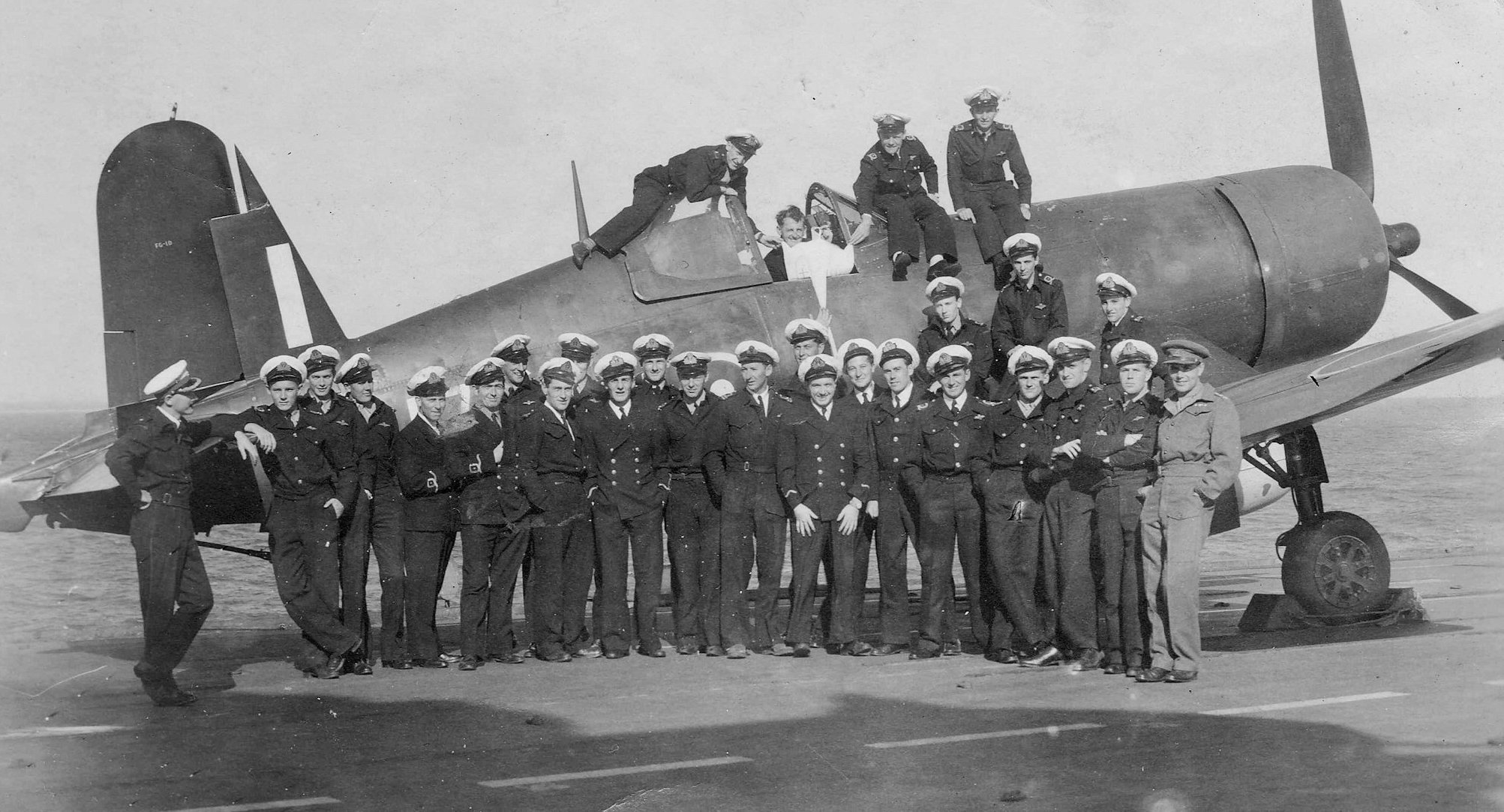 |
|
The officerso f 1846 Squadron pose with
one of their Corsairs on HMS COLOSSUS. C. Spring 1945.
Photo courtesy Mr, Ian Jones. Click on image
to see larger version |
The squadron re-embarked in COLOSSUS on May 4th and she sailed for Malta to re-join VENERABLE and VENGEANCE to complete working up as a squadron; GLORY arrived at Malta on the 22nd to begin her work-up, COLOSSUS, VENERABLE and VENGEANCE departed from Malta the following day for passage to Ceylon on the first leg of their journey to join the British Pacific Fleet in Sydney.
On reaching Southern India
!
Reserve aircraft were flown off to RN AMY Coimbatore? Squadron flying resumed in early June; Lt. Cdr Devonald in KD763 hit the barrier with his starboard wing badly damaging the tip on the 4th.
1846 was disembarked to
RNAS Tambaram on the June 10th. They were the second of the Corsair squadrons to disembark from the three carriers, 1851 had disembarked from VENERABLE on the 7th and 1850 from VENGEANCE arrived on the 11th. All three squadrons were to train on the extensive practise and live firing ranges the station had available, as well as receiving replacement aircraft from RNAMY Coimbatore in preparation for active service. COLOSSUS then sailed on to Ceylon to disembark the Barracudas of 827 to
RNAS Katukurunda
on the 12th, COLOSSUS reached Colombo on the 13th. On June 30th 827 and 1846 squadrons became the 14th Carrier Air Group (14th CAG) for service in COLOSSUS; they re-embarked on July 3rd and 5th respectively, when the ship sailed for Australia.
!
The 13th CAG formed in VENGEANCE with 812 and 1850 squadrons, and 15th CAG in VENERABLE with 814 and 1851 squadrons, all with 24 Corsair & 14 Barracuda.
The 14th Carrier Air Group and operations with the British Pacific Fleet
Unlike the voyage to Ceylon flying was conducted on passage to Sydney. There are four deck crashes and one ditching recorded during this time; Sub-Lt A. Jones RNVR took the barrier in KD827 ('U7S'), after making a low approach he hit the rounddown, lost his hook and hit the ships crane on July 8th. On the same day Sub-Lt J.D. Garden RNVR in KD344 ('U6K'), entered the barrier when his hook jumped the wires; he was to repeat this two days later in KD681 ('U7F'), this time the arrester hook shaft sheared while he was making in emergency landing, and continued on into the barrier. Sub-Lt Richmond had a lucky escape in KD684 ('130/D'),
!
The squadron was changing its identification markings during the passage to Sydney in preparation for joining the BPF.
on the 13th the aircraft swung to port on taking off and went over the side between the port wireless masts, he was rescued safely. The final incident was a barrier crash for Sub-Lt Parr in KD696 ('111/D', YANGTZE NANCY) was also on the 13th; he floated over all the wires and hit the barrier.
The squadron flew ashore to RNAS Nowra, New South Wales on
July 21st, 827 going to RNAS Jervis Bay before the ship entered Sydney harbour. They remained ashore until August 13th, re-embarking in COLOSSUS when she prepared to sail for Manus in the Admiralty Islands. As early as August 10th
it became clear that that Japan was willing to accept the
terms of surrender and all of the ships in Australian waters
had been reallocated to form Task Group 111 in readiness to
reoccupy the former Crown Colonies in Hong Kong (TG111.2!
Task Group 111.2 comprised carriers INDOMITABLE and VENERABLE, Cruisers SWIFTSURE and EURYALUS, PRINCE RUPERT (RCN) and Destroyers KEMPENFELT, URSA, WHIRLWIND and QUADRANT.
),
Shanghai (TG111.3!
Task Group 111.3 comprised BERMUDA (Flag of Rear Admiral Servaes, Flag Officer Commanding 2nd Cruiser Squadron., ARGONAUT, COLOSSUS, TYRIAN, TUMULT, TUSCAN and QUIBERON.
) and Singapore TG111.4!
Task Group 111.4 comprised ANSON (Flag of Rear Admiral Daniel, Flag Officer Commanding 1st Battle Squadron, VENGEANCE and four destroyers.
).
COLOSSUS sailed on the 15th in company with INDOMITABLE,
VENGEANCE, and VENERABLE, followed by cruisers BERMUDA and SWIFTSURE, destroyers QUADRANT, TUSCAN, URSA, TYRIAN, KEMPENFELT and WHIRLWIND;. Flying continued while on passage; there was one barrier crash on the 17th when Lt. C. F. Worthington-White RNZNVR missed all the wires in KD650.
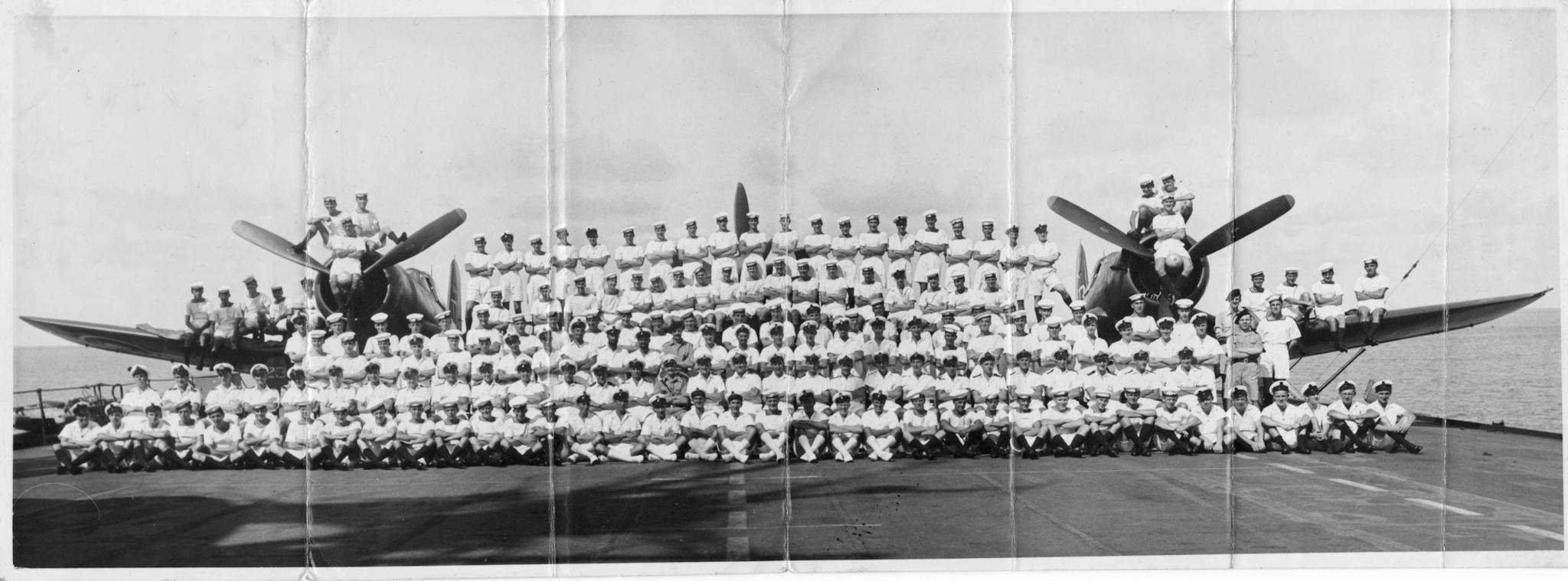 |
|
The officers and men of 1846 Squadron on HMS COLOSSUS
in the Pacifc. August 1945.
Photo courtesy Mr, Ian Jones. Click on image
to see larger version |
Air cover during landing of RAPWI teams
The convoy arrived at Manus on August 20th and COLOSSUS was allocated to Task Group 111.3 comprising Cruisers BERMUDA (Flag CS2) and ARGONAUT, Destroyers TYRIAN, TUMULT and QUIBERON for the liberation of Shanghai.
TG 111.3 sailed for Leyte in the Philippines later that day to await orders: although primarily on a humanitarian mission 1846 Corsairs were to fly combat air patrols (CAP) over the ships on passage.
TG 111.3 left Leyte on September 3rd for Kiirun in Formosa carrying RAPWI (Recovery of Allied Prisoners of War and Internees) teams for the evacuation of POWs, arriving there on the 6th. COLOSSUS and TUMULT remained at sea while BERMUDA, ARGONAUT, and QUIBERON entered harbour. One of the squadron’s Corsairs, KD371, was forced to ditch alongside the ship on the 6th after engine failure, the pilot Sub-Lt Macdonald was picked up OK. Sub-Lt A.L. Budd RNVR made a bad landing the following day in KD270; he swung to port on touchdown and ran his port wheel off the edge of the flight deck. All moveable POWs had already been embarked in U.S. ships and were on their way to Manila. The Hospital Ship MAUGANUI arrived on the 8th and evacuated the sick to Manila. All POWs known to be in Formosa had been evacuated by the 9th of September.
On September 11th, TG 111.3, now joined by BELFAST (Flag CS2), left for the Shanghai area where RAPWI teams were flown into Shanghai by aircraft from COLOSSUS on the 12th; like in Formosa it was planned that the main body enter the harbour while COLOSSUS provided cover off shore but entry was delayed until the 18th when TG 111.3 anchored off the Yangtze Bar. 1846 maintained overhead patrols during this period but without incident. COLOSSUS was next ordered to Jinsen (Incheon) in Korea on the 24th of September to evacuate British and American POWs to Manila. COLOSSUS embarked 354 British and Australian nationals for passage to Manila, arriving on the 4th October; there she embarked 200 Europeans, mainly Hong Kong volunteers for passage to Hong Kong and India.
On arrival at Hong Kong on October 12th both 1846 and 827 disembarked detachments of aircraft to operate from RNAS Kai Tak, re-embarking them on the 18th when the ship sailed to return to Ceylon. On October 26th COLOSSUS disembarked all of her Air Group to RNAS Katukurunda, the ship had been selected for a trooping voyage and the need for maximum accommodation space required the hangar deck and air group accommodations to be empty; she would not return until the end of December 1945.
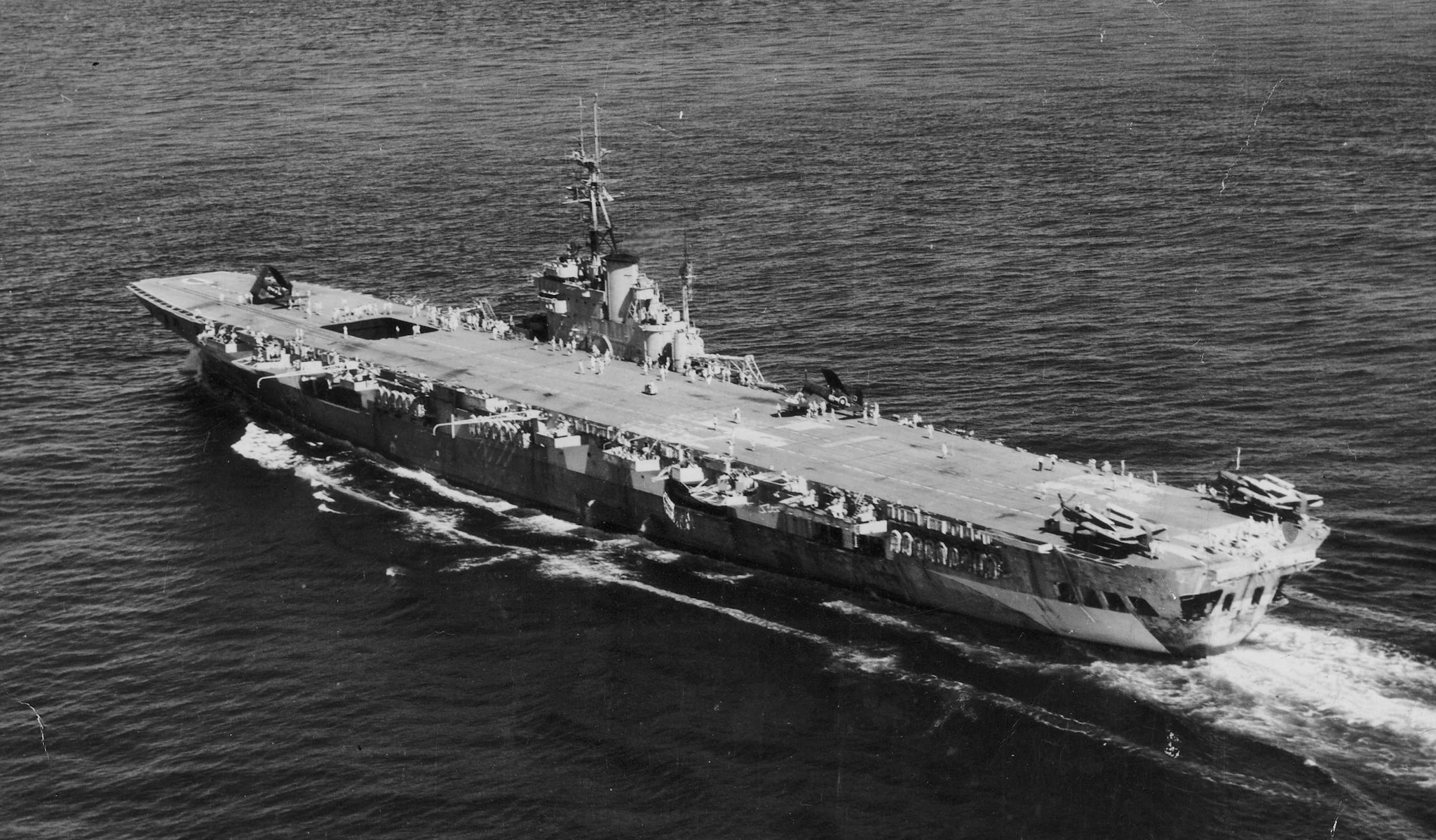 |
|
HMS COLOSSUS in the Pacific C. October 1945.
Photo courtesy Mr, Ian Jones. Click on image
to see larger version |
COLOSSUS refit in South Africa, and subsequent return to the UK
On release from trooping duty COLOSSUS was nominated for refit in HM Dockyard, Simonstown to begin in the New Year. The 14th CAG re-embarked on December 30th 1945 and the ship sailed for South Africa. Both squadrons were disembarked to
RNAS Wingfield, Cape Town on January 17th prior to the ship entering the Dockyard. Peacetime flying training continued while the squadron was in South Africa and a number of new pilots arrived to relieve some of the original squadron members, including Lt. Cdr (A) D.A Dick, DSC, RNVR who took over as commanding officer on February 26th 1946.
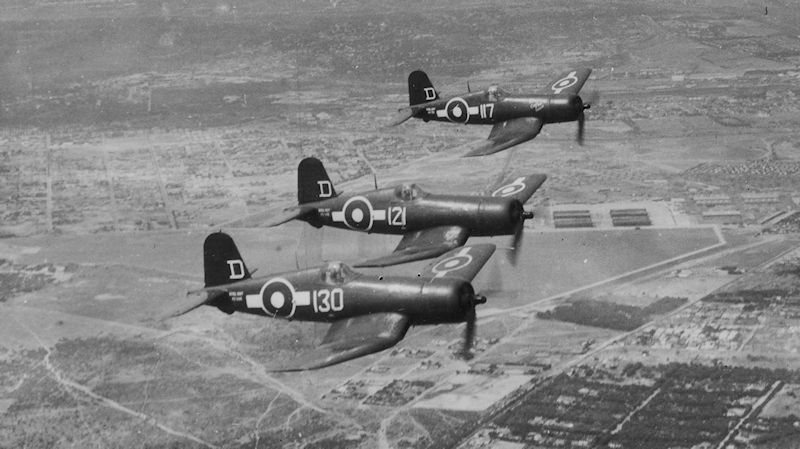 |
|
A flight of Corsairs of 1846 Squadron,
believed to be over Cape Town, C. February 1946.Sub-Lt
A, Jones is in the aircraft furthest from the
camera -
click here to see the nose art on his
machine.
Click on image to
see larger version |
It had been decided that COLOSSUS was to return to the UK on completion of her refit and be transferred to the reserve; her air group would disband on arrival in the UK. The 14th CAG re-embarked on April 8th when the ship was preparing to sail for Ceylon. There was one serious incident during the squadron landing on., Lt. R. M. Orr-Ewing, an air engineering officer pilot, landing in an unidentified Corsair went over the port side injuring two ratings of the flight deck party. He was safely rescued.
The ship sailed on April 13th, arriving off Ceylon on the 27th, and disembarked the 14th CAG to
RNAS Katukurunda. The squadron continued flight operations with the ship while based ashore; on May 3rd Lt E.G. Beechinor made a low fast approach to the deck in KD372, caught a late wire but continued on into the barrier, while on the 7th Sub-Lt J.D. Harmsworth stalled on approach at Katukurunda doing ADDLs in KD750 ('117/D') - the last recorded flying incident.
The Air Group re-embarked for the final time on May 17th for passage home with COLOSSUS, on arrival on the Solent in late July 1946 her squadrons flew ashore, 827 to RNAS Lee-on-Solent on the 22nd and 1846 to RNAS Gosport on the 23rd where they were disbanded.
First-Line squadrons menu |
go to the top
Content revised:
26 September 2021
Primary information sources
Additional sources:
|
Comments (2)
JS519 - Pilot S/Lt J E Jones? 10 Mar '45
JS498 - pilot S/Lt N G Lucas 31 Aug '45
JS881 - pilot n/k 31 Aug 45
I believe the latter two collided during formation aerobatics.
I have these a/c as being with 1846 NAS - any information would be much appreciated.